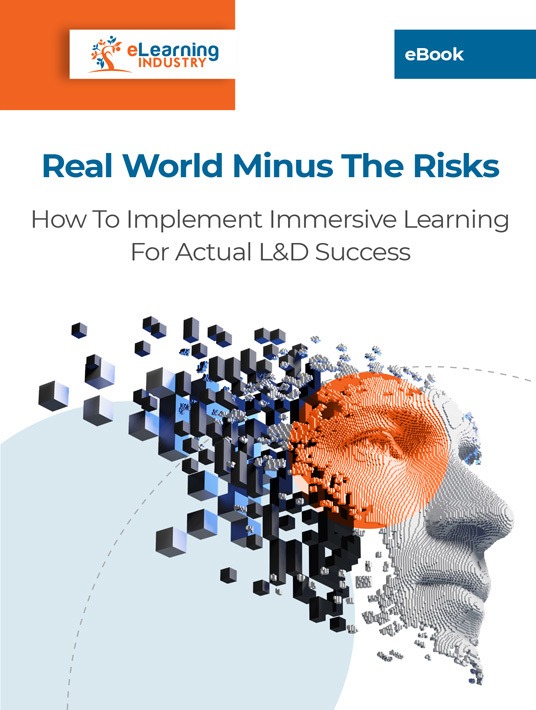Use Immersive Learning For Compliance Online Training
Every organization faces significant compliance challenges that can negatively impact their bottom line. From dress code violations that diminish your brand image to work injuries that raise your insurance premiums. It’s impossible to prepare employees for every obstacle they must overcome, as everyone has unique job roles, responsibilities, and daily tasks that tie in different rules, regulations, and protocols. However, you can use immersive learning and simulation training to instill self-confidence and mitigate risks across the board. Here are 8 compliance issues that are solved with AR and VR training, as well as tips to help you tackle them.

1. Policy Violations
Most employees aren’t trying to be rule breakers or rebels without a cause who simply want to defy the status quo. In some cases, they simply cannot bridge the gap between theoretical knowledge and practical application, such as figuring out how the company policy pertains to their job duties. They know the rules and protocols but aren’t sure how to follow them in the real world. Immersive learning helps them connect the dots and put all their online training into context. For example, they can evaluate the repercussions of not wearing the right safety gear or not informing customers of the return policy after a sale.
2. COI Breaches
Conflict Of Interest (COI) is one of the trickiest compliance topics because there’s so much gray area. What really constitutes a bribe? How should employees avoid showing their friends or family preferential treatment when they step into the role of the customer? AR training clarifies the boundaries and helps employees explore the many facets of COI in a real-world setting. They can also gauge their responses and reflect on performance behaviors to identify weak points.
3. Workplace Accidents
There are some on-the-job injuries that simply can’t be avoided. However, a large percentage of accidents are due to simple mistakes, lack of training or the inability to remember all those protocols, manuals, and preventative measures when they’re busy with everyday tasks. VR training can mitigate risks by building experiential knowledge. Employees live through accidents to learn how to prevent them and the impact their choices/actions have on the entire organization. End your simulation training activities with a brief recap of how employees can avoid similar situations and online training resource links.
4. Safe Handling
Safe handling protocols pertain to virtually every product, not just toxic items like cleaners or hazardous byproduct waste. Immersive learning allows you to stress the importance of proper handling and product maintenance. For example, employees need to know how to clean heavy machinery and handle the components with care. Create simulation training resources that cover every aspect of the monthly maintenance process so that they can prepare for the real thing.
5. Task Implementation Mistakes
Certain tasks leave more room for error because there are multiple steps involved or inherent risks. For example, maintaining that heavy machinery I mentioned above is more dangerous than pitching products—depending on the customer, of course. VR training gives employees the opportunity to practice these processes time and again to improve their approach and prevent common errors to identify sticking points and learn how to navigate them with the available online training resources. There should be an emphasis on cause and effect, for instance, how even a small—but avoidable—mistake can spiral into loss of business or tarnished brand credibility. This way, they understand the gravity of the situation and how their behaviors affect every member of the team.
6. Anti-Harassment
Harassment and bullying are another compliance sector with hazy areas that often cause confusion. For example, when does a co-worker's joke or comment constitute harassment? How do employees report the incident if they weren’t directly involved? Simulation training with VR helps clarify these issues so that employees understand the difference between innocent remarks and veiled romantic advances or threats. They also see how their actions and words impact others and might be perceived as bullying or, at least, offensive.
7. Data Protection
Mixed Reality training can cover the basics of data protection to reinforce employee knowledge. For example, they pull up an AR infographic that covers all the collection and safe storage basics. But you can also immerse employees in data security challenges to see how they react and identify areas for improvement. Maybe the VR training simulation involves an imminent threat or attack on your systems. How do they handle the problem and are there any performance habits or work practices they need to address?
8. Ethics On The Job
The beautiful thing about immersive learning is that it drives the point home. Employees can step into someone else’s role to see from their perspective. This is particularly beneficial for ethics training. Develop VR training simulations that explore the many facets of ethics in the workplace, such as how to respectfully decline a client gift or how to handle a co-worker argument. Diversity should also be an integral part of the process so that employees understand how to interact with different cultures and societal norms.
Some compliance issues are more difficult to tackle than others simply because they’re more skills-driven. Employees must have a solid understanding of the core competencies involved so that they can actually carry out the task. However, immersive learning is one of the most effective ways to pinpoint performance challenges and overcome them with minimal risk involved. Staffers are able to make mistakes that teach them valuable lessons but don’t have a negative impact on your brand reputation.
A Mixed Reality training strategy doesn’t have to drain your organization’s resources or make you go over budget. Download the eBook Real World Minus The Risks: How To Implement Immersive Learning For Actual L&D Success, and discover how you can benefit from incorporating immersive learning into your online training program. Provide an engaging training experience and boost your employees’ confidence with a Mixed Reality training solution.









